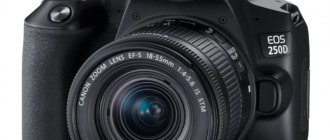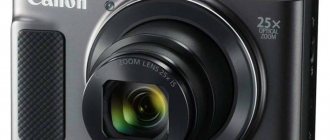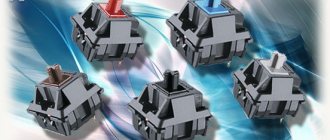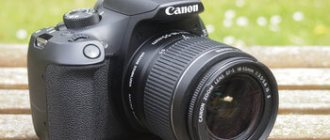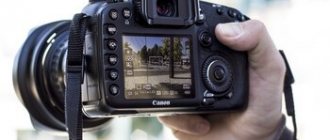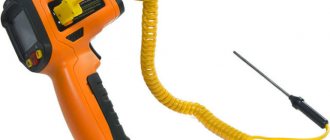Digital cameras are the most common in the modern world. One type or another of these cameras is found in literally every home. They are used by both people who are not interested in photography to capture memorable moments, as well as professional photographers. This article will talk about what types of digital cameras exist and what advantages and disadvantages each of them has. After all, equipment in this category is of the greatest interest, and the cost can vary tenfold.
Fully automatic compact cameras
This type of digital camera independently selects all settings. That is why it is very easy to use: all that is required of the photographer is simply to point at the desired frame and press the shutter button. If necessary, the flash will automatically fire, increase the exposure or change the white balance. This type has quick settings related to the type of shooting taking place. You can select the desired mode, for example, “portrait”, “landscape”, “macro”. By going to the menu, you can manually set the ISO values, white balance, turn the flash on or off, and on some models, control its strength.
Digital cameras of this type usually do not have very good picture quality. You can get a sharp and detailed photo only in good lighting. Also, usually such cameras have a small digital zoom, and the optics are not very high quality. These criteria are important even for beginner photographers, but using compact digital cameras is great for capturing memorable moments just for yourself, family and social media. The cost of such cameras starts from about 2 thousand rubles.
The advantages of such models:
- Small in size, the “compact” will easily fit into your pocket;
- Automatic adjustment, you do not need to have any experience in shooting to use this technique;
- A considerable part of the models are powered by ordinary AA batteries, which can be purchased in almost any part of the world;
- Low cost.
Minuses:
- It is unlikely to obtain truly high-quality images;
- Poor quality optics;
- The lack of manual adjustment of parameters is also a disadvantage, since everyone, even slightly familiar with the shooting process, strives to improve the result;
- Small battery capacity;
- No viewfinder.
10 legendary Soviet cameras (11 photos)
Author: Serg Pavlov
21 July 2014 15:37
Tags: USSR top10 cameras
42959
11
This time we would like to talk about the legendary devices produced in the USSR: although the vast majority of them are clones of Western models, among them there were also interesting devices with which many have warm memories.
0
See all photos in the gallery
Smena-8M The creative path of many Soviet and post-Soviet amateur photographers began with this primitive camera (in the illustration above). Scale focusing (that is, “by eye”), a minimum set of shutter speeds and apertures, the absence of an exposure meter - all this, with proper skill, could not prevent getting good pictures, especially since the Smena-8M was equipped with a good and fairly sharp triplet lens with a focal length 43mm distance and f/4 aperture.
0
Leningrad In the Soviet Union, many clones of German rangefinder cameras were produced. However, in addition to the FEDs (which were poor copies of Leica) and Zorkikhs (which were a further development of the FEDs), the USSR also produced a truly unique device called Leningrad (1953-1954). It is interesting primarily because it used a spring mechanism, which allowed continuous shooting at speeds of up to 3 fps, and the factory was enough for 12 frames. Other characteristics were also good for their time: a lamella shutter with a shutter speed range from 1 to 1/1000 of a second, a 57 mm rangefinder base, an unusual viewfinder with parallax correction and a “mirror zone” instead of the “double spot” usual for traditional rangefinders. The camera uses interchangeable optics with an M39x1 thread and a working length of 28.8 mm (the same as FEDs and Zorkiye).
0
Zorkiy-4 Cameras of the “Zorkiy” family were probably in every Soviet family. The most popular of them was Zorkiy-4, which was produced practically unchanged from 1956 to 1973, its total circulation amounted to more than 1 million 700 thousand units. Like previous Zorkih versions, the fourth model is equipped with a curtain shutter with a shutter speed range from 1 to 1/1000 seconds and uses lenses with an M39x1 connecting thread. By the way, there is no built-in exposure meter in Zorkom-4, so to create photo masterpieces it was necessary to either estimate the exposure by eye or use a manual exposure meter.
0
Kyiv-2 Another legendary Soviet rangefinder, the legend of which mainly comes down to the fact that it is an exact copy of the Contax II, and early batches of cameras were even assembled from Contax parts, a large stock of which (along with production equipment) was exported from Vostochnaya Germany for reparations. Due to their successful design, Kiev rangefinder cameras were produced virtually unchanged until the 80s. Compared to other Soviet rangefinders, they had a very large and bright viewfinder, were equipped with a lamellar shutter with a shutter speed range from 1 to 1/1000 (in early models - up to 1/1250) seconds, and a Kyiv/Contax mount was used to attach lenses.
0
Kyiv-10 and Kyiv-15 Kiev produced not only rangefinder cameras, but also SLR cameras. The most interesting models, in my opinion, were “Kiev-10” and “Kiev-15”, and “Kiev-10”, released in 1965, became not only the first Soviet camera with automatic exposure setting, but also the first in the world (!) camera with shutter priority mode. Unfortunately, it used an outdated selenium light meter, which was also located outside the camera body. This drawback was corrected in the Kyiv-15 (produced since 1976), which was already equipped with a TTL exposure meter based on cadmium sulphide photoresistors (CdS). The main disadvantage of the cameras was the unique and incompatible bayonet mount. Soviet lenses for "Kyiv-10" and "Kyiv-15" were designated "Avtomat" (for example, "Helios-81 Avtomat").
0
0
LOMO Compact-Automatic Probably the most famous Soviet camera, which gave rise to a whole movement - the so-called “lomography”. It is a “point-and-shoot” with scale-type focusing (i.e. “by eye”) and automatic exposure setting. The camera was equipped with a fairly sharp Minitar-1 lens with a focal length of 32 mm and f/2.8 aperture. Probably the only Soviet camera that is still being produced (by order of the Lomographic Society).
0
Salute The camera, which was called the “Soviet Hasselblad” - in fact, the Hasselblad 1600F was adopted as its model during design. Designed for shooting frames measuring 56x56 mm on medium format film type 120 or 220. All accessories for the Salyut are fully compatible with early Hasselblads, including film backs, interchangeable accessories and lenses. The camera was equipped with a focal length shutter with a shutter speed range from 1 to 1/1000 seconds. In total, 13 B-mount lenses were produced in the USSR, intended for use with Salyut and Salyut-S.
0
Horizon It is now we, spoiled by digital technologies, who take panoramas for granted. And in film times, shooting panoramic shots was associated with a huge number of difficulties. Oddly enough, one of the best panoramic cameras in the world, the Horizon, was produced in the Soviet Union. The lens and shutter in this camera were mounted on a rotating drum; the frame size on standard 35 mm film was 24x58 mm. One of the secrets to the success of the Horizon was the lens - a very sharp four-lens anastigmat MS OF-28P, which was originally developed for military applications. In Soviet times, it was very difficult to buy a Horizont, since the vast majority of cameras were exported.
0
Zenit-19 There were many different models of Zenit cameras produced by the Krasnogorsk Mechanical Plant, but Zenit-19 is rightfully considered one of the best. This device has a mirror viewfinder that displays more than 90% of the frame (in earlier models - only a little more than 60%) and an electronically controlled lamella shutter that operates shutter speeds from 1 to 1/1000 s (earlier Zenits had a shutter speed range from 1/30 to 1/500 s). The device was produced until 1988; the most reliable models are those released in 1984 or later - they were equipped with a redesigned shutter (such cameras can be distinguished by the synchronization shutter speed, which is 1/125 s instead of 1/60 for models with the old shutter).
0
Almaz-103 and Almaz-102 The Almaz cameras were the first and last attempt by Soviet engineers to create a professional small-format reporter camera. The Nikon F2 was taken as a sample - a very reliable professional camera with interchangeable viewfinders and focusing screens. A fundamentally new mirror mechanism and a metal lamella shutter with a vertical stroke, capable of operating shutter speeds from 10 to 1/1000 s, were developed especially for the camera. To attach lenses, a K mount was used (as on Pentax SLR cameras). The Almaz-103 model was considered basic and was not equipped with a built-in exposure meter, but Almaz-102 already had a TTL exposure meter with digital exposure indication in the range of +/- 2 steps. Unfortunately, "Diamonds" became legendary for a completely different reason - as the most unreliable Soviet cameras. The manufacturing plant (LOMO) did not have the equipment to produce parts with the required accuracy. Due to processing problems, the parts of the cam mechanism in the shutter were made not of steel, but of brass, which quickly produced chips that fell into the camera mechanisms and jammed them. As a result, “Almazov-103” was produced just under 10 thousand copies, and “Almaz-102” - only about 80 (not thousands, but copies) due to problems with the supply of the necessary electronics.
Source:
Related links:
- Museum of Soviet Childhood
- Yard ventures of Soviet children
- Children's games that are becoming a thing of the past
- Cameras from the times of the USSR (19 photos)
- Funny
Tags: USSR top10 cameras
Do you like to remember how things were before? Join us, let's feel nostalgic together:
31 4 27
Liked
27 1
33
Partner news
Cameras with advanced settings
This type is suitable for people who understand the settings a little better. Cameras of this type already have photo shooting modes, which expands the range of possibilities. Here you can often find several modes, such as:
- Shutter priority mode, which is indicated by the symbols Tv or S;
- Aperture priority mode, with Av or V symbols;
- Manual mode, indicated by the M symbol.
Thanks to this, you can control the shutter speed or aperture, or completely adjust the parameter values manually. Using a variety of parameters, you can create good pictures in not the best conditions and achieve interesting effects. To do this, you need to be able to handle a digital camera and have the skills to use the modes.
Digital cameras with advanced settings use higher quality lenses with more complex optical glass structures. At the same time, the zoom on such cameras can be many times higher.
Photographic equipment of this type have significant advantages over fully automatic ones:
- Simplified access to most of the necessary settings;
- Good quality of equipment and optics;
- Some models are equipped with a viewfinder.
They also have disadvantages:
- A considerable part of such models, despite their name, are not at all compact;
- The price range is very wide.
The cost of this type of camera can vary greatly, but, in general, it starts from 5 thousand rubles. They are perfect for photography beginners who are just starting to master professional settings.
How to choose a digital camera
We have all made many purchases in our lives, ordinary and large, and in each of them, when choosing what to buy, we were guided by both emotions and rational needs. Most likely, for most people, a rational purchase will be something purchased for household needs - from toothpaste to a refrigerator. Some things lie somewhere in the middle, for example, devices used for entertainment may be chosen rationally, but also bring us many emotions. Over the past years, some items have ceased to be a necessity, for example, a wristwatch has turned from a necessary thing into an accessory. However, there are still devices that were and are now chosen by the heart - one of such devices remains the camera.
The fact is that each of us already has a smartphone, which is quite suitable for simple pictures. When a person purchases a camera as a separate device, a creative approach to the photography process is assumed.
It would seem that the fact that the majority chooses a camera as their “heart” should lead to an increase in the variety of this type of equipment. But in fact, for many novice users it comes down to the principle: “I’ll buy what is from friends and passers-by.” As a result, many interesting models and systems are deprived of the attention of buyers.
Therefore, we will talk about all the major devices whose main function is to capture a static image called photography.
To understand how cameras differ from each other, you need to know what they actually consist of.
Any camera includes the following parts:
- Photosensitive element. In the case of digital cameras, this is a flat matrix with sensors - pixels. Each pixel captures light in a specific color range, typically one of the three primary colors (red, green, blue).
- Lens. A lens is a system of lenses whose task is to project an image onto a matrix.
- Gate. This is a mechanical device that blocks the light on the path between the lens and the matrix. The shutter is capable of opening for a certain time, called shutter speed.
- Frame. Despite the similarity of the basic layout, cameras from different manufacturers differ greatly in appearance. This is part of the advertising strategy in which manufacturing companies invest. For example, Giorgetto Giugiaro, a famous automobile designer, worked on Nikon DSLR cameras.
- Controls. Cameras are heavily decorated with all kinds of buttons, switches and wheels, and they are actually used for all the functions that are inherent in these works of engineering.
- Internal electronics. In addition to the matrix, the digital camera has its own built-in computer, with its own processor, memory and other elements.
- The screen is for digital cameras.
- Viewfinder. This is an eyepiece, the image in which can be observed by bringing the camera close to the eye.
- Battery.
- Memory card slot.
Ideally, you should be aware of all of these elements when choosing a camera.
Perhaps the most important characteristic of digital cameras is the size of the matrix. The larger it is, the more light falls on it, and the higher its light sensitivity and the more capabilities the camera has. But, naturally, the larger the matrix, the larger the lens and the more space the camera takes up as a whole. That’s why, for example, you won’t find a large matrix in smartphones; its diagonal is measured in millimeters.
And if you see a huge lens in the hands of a photographer, you can guess that the engineers turned it out this way because of the size of the matrix for which it is intended.
The second parameter that is worth paying attention to is the ability to change lenses. The fact is that it is the lens that determines the genre functions of the camera, and accordingly, the ability to change it expands them.
These two parameters determine which class a particular camera belongs to.
Compact cameras
Guided by simple logic, we can assume that small cameras should be called compact. This is true, but not entirely. Rather, compact cameras are cameras with a small sensor size. Today, there are only two of its formats used in cameras of this class.
- 1/2.3″. This is the smallest format, the advantages of cameras with it are low price and large zoom.
Nikon Coolpix A100
Canon PowerShot SX620 HS
- 1". “Professional” compact format, lightweight, with image quality suitable for further processing and commercial use.
Sony Cyber-shot DSC-RX100 V
Among compact cameras, so-called “ultrazooms” are distinguished - cameras with a large range of focal length changes, and, therefore, high versatility. Modern ultrazooms even allow you to photograph astronomical objects.
Nikon Coolpix P900
There are also protected compacts that are waterproof and shockproof at the same time.
Cameras with interchangeable lenses
Interchangeable lens cameras have historically had a much larger sensor size than compact cameras. These are interrelated things: due to the fact that lenses are larger, it is impossible to develop one for all occasions. The standard scenario for a photographer is this: one or two cameras and a much larger number of lenses are used, because to cover all genres of photography it takes about five of them.
Interchangeable lens cameras are one of the following two types.
DSLR cameras
These are cameras with interchangeable lenses and a viewfinder, the image in which is formed independently of the camera electronics thanks to a system of two mirrors (or a mirror and a prism). This is the most “long-lived” type of camera, with a huge fleet of lenses and other additional accessories.
Canon EOS 800D with Canon EF-S 18-200mm f/3.5-5.6 IS lens
DSLR cameras are popular in areas where camera reliability, a large battery life (work without charging the battery) and compact sizes are not required.
All modern DSLRs can display an image of the subject being photographed on the display (LiveView mode), but this reduces the speed of autofocus and burst shooting (when a continuous series of pictures is taken while the shutter button is pressed).
Mirrorless cameras
They also have the ability to change lenses, but here you can observe the object you are shooting only using the display (or an electronic viewfinder, which is essentially a small display with an optical eyepiece).
Mirrorless camera bodies are smaller than DSLR cameras and lighter. For example, the Canon EOS M6 mirrorless camera itself weighs 390 grams without a lens, while the lightweight EOS 200D DSLR weighs 453 grams.
Canon EOS M6
However, there are exceptions.
Panasonic Lumix DC-G9
General Tips
The specific camera you choose depends greatly on what level of photography you're interested in.
If you are a complete beginner and want a camera that just takes pictures, then a simple compact with a minimal set of settings will be enough for you. There are even children's models of this class.
If your camera is something more than a household device for photography, it is better to buy a compact with an inch matrix or a mirrorless camera. DSLRs are also suitable, but not professional ones, since the latter are simply too large for the average user.
Professional photographers, for whom compromises are unacceptable, can probably recommend the camera to anyone.
Some people choose a camera not only and not so much for photography as for video shooting. In this case, the format and resolution of the video recording are important, as well as the capabilities of the video mode itself (for example, manual mode, special image profiles, support for outputting an uncompressed video stream).
If you were able to narrow down the choice of camera to a specific class or manufacturer, you can also pay attention to important but not decisive things: the presence of a rotating touch screen, support for high-speed memory cards, the use of external flashes, interfaces, and so on.
The appearance of cameras can be important for many, because we choose them emotionally, as mentioned at the beginning of the article.
conclusions
Cameras are perhaps the type of technology in which there really is a lot to choose from. Its manufacturers can introduce new products one after another, but they never engage in outright plagiarism; often a knowledgeable person, having seen only one detail of the “appearance” of an unfamiliar camera, can tell which company it was developed by. Moreover, this may not be a purely decorative, but a functional element.
In addition, choosing, for example, a camera with interchangeable lenses will lead to the fact that you will most likely buy lenses for it. And lenses are a separate topic for discussion, which could be the subject of a separate article
As a result, choosing a camera can be an interesting process in itself. However, we do not recommend getting too carried away with this, because it is after the purchase that the fun begins.
Superzooms
Superzooms are the same “compacts” with improved zoom. They also have a number of manually changeable parameters. Their main difference is the multiple zooms of the frame. Such cameras have a fixed zoom lens that is several times superior to the optics of other “compacts”. While they have a maximum magnification of 20x, the superzoom can go 30-60x closer.
An important feature of this type of digital camera is the presence of stabilization. This allows you to create clear shots without a tripod.
Advantages of models of this type:
- Multiple zooms;
- Small dimensions and weight;
- A number of parameters that can be configured manually;
- Relatively low cost.
Minuses:
- Not the best photo quality;
- Small number of manual settings;
- Impossibility of obtaining professional personnel.
Mirrorless cameras (system cameras)
The system camera got its name due to its modular design. Those. this is a photosystem. Like SLR cameras, system cameras have an impressive array of removable lenses, flashes and other modules that allow you to take very high-quality professional-level photographs.
In some cases, the viewfinder of a system camera is located separately and is not part of the optical system of the camera. Those. the photographer sees only the outline of the frame, unlike a DSLR, where the viewfinder is part of the optical system of the camera, and the photographer has full control over the adjustable parameters.
Currently, many system cameras have an electronic viewfinder, which uses the camera’s matrix as the primary source. As a result, the shooting process is no different from a DSLR. The photographer also sees the frame as it will be taken, as if he were taking the picture through a SLR camera.
System mirrorless cameras have smaller dimensions and weight, but comparable quality characteristics to SLR cameras. Therefore, mirrorless system cameras now have a huge number of fans in the photography community.
By the way, SLR cameras are also system cameras (since they are also photosystems), but this description has never been used for them.
Prosumer cameras
This type of digital camera is suitable for enlightened amateurs; with its help, good professional photographs can be obtained. They also have three shooting modes: shutter priority, aperture priority and manual. Such a digital camera is capable of continuous shooting, creating several frames per second when you hold down the shutter key. The flash of this type of camera is much more powerful. Also, some models make it possible to use an external flash, and sometimes you can even control the lighting from a distance. Various types of light filters and additional attachments are produced for prosumer digital cameras.
In addition to a variety of settings, digital cameras of this type have a larger matrix, which makes it possible to take pictures in good resolution and have high-quality optics.
The possibilities with this type of camera increase significantly; the main thing is to remember that the settings system here is very difficult for beginners. It’s quite easy to create high-quality images in difficult conditions with prosumer photographic equipment, as long as you understand how all the parameters work. This type is often used by professionals when it is not possible to take a lot of equipment with them.
Positive sides:
- Ability to work with settings on a large scale;
- Very good image quality, ability to shoot in RAW format;
- Good quality of technology and optics;
- The ability to create professional-level photographs;
- Powerful flash, the ability to use external additional lighting.
- Availability of light filters and various attachments.
Negative sides:
- The need to have certain skills to use;
- Expensive.
In terms of cost, prosumer cameras are comparable to SLR cameras, and in some cases even exceed them.
Types of cameras
Based on the method of image formation, cameras are divided into two types: film and digital . All the many devices that can be found in hardware stores either shoot on film or “write” digital images into memory; there is no other way.
Film cameras
A film camera forms an image on light-sensitive film. It is coated with a chemical that captures the “imprint” of the picture depending on its illumination and distance to it. Afterwards, the film is processed and the image is transferred to paper. The frame turns out analog. The quality is high even at maximum magnification.
Important! Nowadays, a good digital camera can also take decent quality pictures. Therefore, film devices with their shortcomings are consigned to history. This is a technique for fine connoisseurs, “gourmets” of photography.
Advantages:
- the ability to manually set focus and shutter speed, that is, control effects and photo quality;
- analog image quality;
- Expanded functionality is possible in the form of a self-timer and photo exposure meter.
Flaws:
- Finding a film camera on sale is difficult;
- consumables (for example, films) are even more difficult to find;
- a small number of frames on film; for large-scale filming it is necessary to have spare reels;
- films need to be developed, and finding a studio where they do this, or reagents for independent work, is also not easy.
In digital devices, the initial path through which the light passes, carrying the picture, is the same as in film devices. But the image is recorded not using chemistry, but on a light-sensitive matrix. The picture is saved in memory as an information file.
Digital compact camera
These are the “soap boxes”. They are inexpensive, but they can also do a little. At some point, every tourist, yes everyone, had such a technique.
Important! Nowadays, photographs of similar and even better quality are taken by phones, so there is no need to carry an extra item with you. The peak of popularity of soap boxes has passed. They are bought for children (there are even devices with children's designs and built-in games) or elderly people.
This type of camera is suitable as a main one, if you take the most advanced options. A minimum of settings, just one button, and at the same time a more or less decent amateur photo - this is how compact models can be briefly described.
Advantages:
- the price of simple models starts from 3-4 thousand rubles;
- easy to use, even an elderly person or child can handle it;
- frame size 3 by 4;
- Such cameras operate on AA batteries.
Flaws:
- even cameras with large zooms have a small sensor, so this is only an illusion of quality;
- low picture quality, no “sport”, “night” and other modes;
- Most often, simple, cheap optics and electronics elements are installed here.
Reflex camera
A DSLR camera combines the best of an analog camera and a digital one . There is a viewfinder, and the light-sensitive matrix is covered with a mirror, which tilts exactly at the moment of shooting. Thanks to this solution, the camera can take pictures of moving objects, has very fast autofocus and other features that allow you to take professional-quality shots. Typically, these devices are equipped with good matrices (minimum medium format), and the shooting resolution can reach 38 megapixels.
Important! The price of such cameras is considerable. The simplest “DSLR” costs about 17-20 thousand rubles.
Advantages:
- the equipment instantly reacts to the photographer’s actions;
- the ability to change optics, there is a viewfinder;
- excellent shooting quality, including in motion;
- wide functionality;
- possibility of using interchangeable lenses;
- Usually DSLR cameras look very stylish;
- energy efficiency - the battery allows you to take up to 1000 pictures without recharging.
Flaws:
- price;
- Usually such cameras are quite heavy and bulky, and it’s inconvenient to take them with you to photograph everything around you every minute (like a point-and-shoot camera).
Mirrorless camera
A mirrorless camera does not have a mirror or an optical viewfinder. Thanks to this, the devices are more compact. The matrix here can be as good as that of SLR cameras, so the quality of photographs hardly suffers. There are also a lot of functions here, this camera is quite suitable for beginner photographers. For convenience, the camera has a screen; new models have a touch screen, up to 5 inches in size.
Advantages:
- the camera has many options: image stabilizer, white balance, the ability to change optics, even one that cannot be installed on a DSLR camera;
- compact size;
- convenient screen;
- good quality of pictures.
Flaws:
- no viewfinder;
- This type of camera quickly consumes battery power and does not last long.
Instant camera
Now this is not a variant of an analog camera, but a device stuffed with electronics. Despite the lower quality of pictures than that of advanced digital cameras, these babies can also do a lot. There are models with video capabilities. Most instant cameras have effects for image processing, data transfer via Wi-Fi, and the ability to zoom in on the subject. This camera is suitable for those who love photography on paper, and for young people traveling, as you can immediately give the photo to friends.
On a note! An instant camera is now an excellent option for a fashionable, stylish gift.
Advantages:
- you can immediately apply photo effects;
- the camera itself is small and light, often has an interesting design;
- there is a flash, many features of a regular camera are available.
Flaws:
- limited number of frames (usually about 20) and the need to constantly buy more paper (although it is freely available, there are no problems with it);
- If you add up the cost of the camera itself and its components, the price of one frame will be high.
These are not all types of digital cameras. There are also rangefinder and medium format devices. The first ones have a large focus, minimal delay when shooting, the viewfinder sees the image at the moment of shooting. The latter can be chosen for professional photography: they provide the highest possible image quality (up to 40 megapixels) and have many photo effects. The best possible optics are installed here. The price of such a camera, of course, will also be maximum.
SLR Cameras
This type of digital camera is professional. Its operation provides close control over any settings. That is why this type is suitable for photographers with a high level of skill. SLR digital cameras have a large matrix, which allows you to achieve the highest quality images among equipment in an affordable price segment.
An important distinguishing feature of this type is the instantaneous response of the shutter key. There is no time lag between the moment the camera is released and the photo is taken, ensuring clear photos even when shooting on the move.
A digital SLR camera can be purchased in “body” form, which means only the body, without optics. But each camera is sold complete with a standard lens, which is universal, which will not allow you to fully demonstrate all the capabilities of the camera. For high-level shooting, it is better to purchase a higher quality lens for the required purposes. This pleasure is not cheap, but it will help you get better results and use all the capabilities of this type of photographic equipment. Also, there is always a huge variety of additional accessories available for DSLRs.
DSLR cameras have many advantages:
- Full control of all settings;
- Obtaining professional personnel with excellent quality;
- Good quality of both technology and optics;
- Availability of all kinds of filters and accessories;
- Speed of work;
- Replacement optics in large quantities for a wide variety of purposes;
- Powerful flash, use of external lighting, etc.
The disadvantages include:
- Considerable dimensions of the cameras themselves, optics and additional equipment;
- Considerable cost of both the body and lenses;
- Making some noise;
- Various particles can get inside the camera, which can lead to spots on the photo and damage to the equipment.
The minimum cost of this type is approximately 10-15 thousand rubles.
Compact cameras (point-and-shoot cameras)
A distinctive feature of compact cameras, i.e. “Soap boxes” among the people have always been user-friendly. Operating the camera was always as simple as possible. The flash operates in automatic mode, all shooting parameters are set automatically. The user of this technique can only catch the subject in the lens and press the button. All.
Depending on the manufacturer and price, the quality of images from such point-and-shoot cameras varies greatly. However, pictures from such cameras can always be characterized as follows:
- Low maximum light sensitivity (ISO) of the matrix due to its small size. As a result, images are noisy in low light.
- Slow autofocus. Due to this, dynamic scenes always turn out blurry.
- The flash is located in close proximity to the lens. Due to this, light reflected from the retina of the eye enters the lens, causing the “red eye” effect.
- Minimum number of settings. Almost everything is automated. Even manual mode is not completely manual in the usual sense of the word.
- Small lens aperture. Comparable to the aperture of a door peephole. So that.
The advantages of soap dishes include the following properties:
- Light weight.
- Small size.
- Relatively low price.
The point-and-shoot camera is convenient for use on trips, on vacation, when you need to take an unusual, random shot. Although now many smartphones can easily replace many existing soap dishes in terms of their properties. Technology does not stand still.
By the way, there is one good logical continuation of point-and-shoot cameras - the so-called “ultrazoom” . Essentially, these are point-and-shoot cameras with improved technical characteristics of the optical system, matrix, autofocus, etc. Some models of such cameras are an order of magnitude more expensive than their younger counterparts, and the pictures taken are many times better than those from budget SLR cameras.
Mirrorless cameras with interchangeable lenses
Mirrorless digital cameras began to go on sale not so long ago. During the shooting process, they differ little from mirror models. The main difference and advantage is the absence of a mirror, which makes it possible to reduce the dimensions of the case. Also, this type of camera has an LCD display with which you can focus. The combination of these criteria with the fact that these cameras are otherwise as good as DSLRs creates a demand for such equipment.
But mirrorless digital cameras also have their drawbacks. In particular, there are difficulties with quickly managing settings and working with massive lenses, which is so necessary for reportage shooting.
A digital camera is an indispensable thing for a photographer of any level. There are enough types of such cameras to please everyone: people who are far from photography will like fully automatic models, beginners will like “compacts” with advanced settings, amateurs will be able to learn using prosumer cameras, and DSLR and mirrorless cameras will suit professionals. It won’t be difficult to choose a model that suits your specific goals, capabilities and budget.

